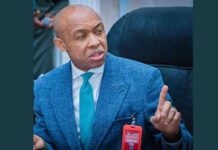Education Minister, Professor Tahir Mamman had attempted to fire a gunshot into a crowded gathering earlier in the year, when he took the floor at the 2024 Joint Admissions and Matriculation Board’s Policy meeting on education, which was held in Abuja on July 18. The minister had seized the opportunity of the meeting to affirm his position on the age limit for university admission, which he had pegged at 18. The hall, filled with professors, education stakeholders, and professionals immediately became charged. The Nigerian No gree for anybody spirit overtook the acadas in the hall as their shouts of No! No! Dwarfed Maman’s presentation. The minister could not proceed as he had to ask: “Are we together?”
Though he eventually delivered his message, by announcing the decision to benchmark university admission at age 18 henceforth, the signal that a major resentment lies ahead was already sent to the authorities by that micro gathering. The commotion that took over the meeting venue made the minister bid a temporary retreat as he agreed that implementing the 18-year benchmark for university admissions would be delayed till the 2025/26 admission cycle, a one-year delay. He, however, gave a strong hint that the 18-year rule would be firmly implemented from next year.
Last week, Professor Mamman returned to the unfinished business. He announced while speaking on a Channels Television programme, Sunday Politics, that students under 18 would not be allowed to write WASSCE, NECO, and JAMB unless they were 18; the same age qualifies them for admission into the universities.
Though the minister’s position is not an innovation by any means, it sounded like an invention in the ears of many. The piece of news he released sounded the alarm across the land. Parents, teachers, education enthusiasts, and stakeholders have been weighing in on the matter from different angles. If I may recall, the 6-3-3-4 education policy was mooted in Nigeria in 1983, while its full implementation kickstarted in 1988. The 9-3-4 education system was equally mooted in 2009, a supposed upgrade on the earlier policy. Whichever policy we are talking about, each recognises that a child should be enrolled in primary school at the age of six, spend six years and another six years in secondary school, while he completes tertiary education with the last leg of four years. The essence of the 6-3-3-4 policy was to promote technological education and ensure that several students embrace technical skills along the education channels such that the rush for university education is reduced to its barest.
As it has always been with the implementation of government’s policies and programmes in this clime, everyone interprets the law his or her way. Education, incidentally is on the concurrent legislative list, which means that the federal and state governments can legislate on the item. Even though the policy by the federal authorities was acceptable to all parties, its implementation was left to the mercy of To Whom It May Concern. The states took their path, the same for the federal and the private stakeholders in the sector. So a situation the Abami Eda, Fela Anikulapo Kuti called confusion break bone was unleashed on the sector.
Whereas the entry point into primary schools was well defined, hitherto, no one knows exactly what the entry or exit age from primary schools looks like anymore. Incidentally, the method adopted in recruiting children into primary schools in the 1970s was regarded as crude. A situation by which a child’s hand touching the ear across his head is a determinant of age six wasn’t scientific, but it worked. With the 6-3-3-4 system, some states adopted the British education model, some adopted the American system. Some schools run a creche, pre-KG, KG, and primary class. Some schools canceled primary six, while some allowed their wards to graduate to secondary schools from primary four or five. So you start having 13, 14-year-olds graduating from secondary schools. I doubt if all such children are classifiable as high flyers. But they ended up being pushed by parents who were worried by societal vicissitudes.
One, the fact that the housewife culture was evaporating from our sphere meant that working-class mothers had little time to spare unlike the years before. Then many were concerned with the uncertainties around the education system due to incessant strikes by ASUU, NASU, SSANU, and their equivalents in the tertiary institutions.
So, it became a situation of catching them young, or the earlier the better, because children end up spending seven, or eight years for four-year courses in the universities. But the push from parents has its drawbacks. While it worked for some children, it never worked for others, who got lost along the line. The effect is what we see today as the falling standard of education.
Opinions have been varied on this matter. Some have tagged the minister’s position as a North versus South battle. Some have said it will retard the children who are already in secondary school. Lots of implications are out there, especially if the government insists that children who would not be 18 in the graduation year won’t be allowed to write the next WAEC or NECO. Renowned lawyer and elder statesman, Chief Afe Babalola weighed in last week by saying the 18-year admission policy would amount to an affront to university autonomy. Others have expressed differing views.
The argument by the National President, Parents Teachers’ Association (PTA). Alhaji Haruna Danjuma and the CEO of Flourishgate Consult, Mrs. Dideolu Adekogbe on the matter, however, appear appealing. Danjuma said that the idea being projected by Minister Mamman was not a new one, adding that when children write WAEC And NECO at 18, it means they have reached the maturity age. Adekogbe harped on the National Policy on Education, saying: “If the National Policy on Education is the guiding document for our nation’s education plan, then it should be followed to the letter-unless we decide to review it. As long as it remains unchanged, it must be fully implemented.”
The situation we have, however, found ourselves in is such that the Bible recognised as “for all have sinned and come short of the glory of God.” (Romans 3: 23). Given that situation, I will not advocate a blindfolded implementation of the rule as Adekogbe stated above.
As it is now, more than half of the children presently in SS1, SS2, and SS3 would miss the age cap when they are due to register for WASCE, NECO, or even JAMB. So what do we do to these children who are already in the trap? The Federal and state governments should henceforth admit their laxity, while they resolve to henceforth enforce the entrance age of children into primary schools, exit age from secondary schools, and the university benchmark. If we insist on shutting the door against the under-18 children in the next WAEC, NECO, and JAMB, millions of children would have been nailed to the cross and their future dropped in the dungeon. In fact, we are already hearing that some unscrupulous parents are resorting to procuring declaration of age affidavits and altering the birth certificates of their wards to beat the rule.
As much as one will agree that it is not right to circumvent the law, the minister and stakeholders just have to find a middle-of-the-road approach by creatively implementing the age cap to avoid a huge commotion in education starting from early 2025.










